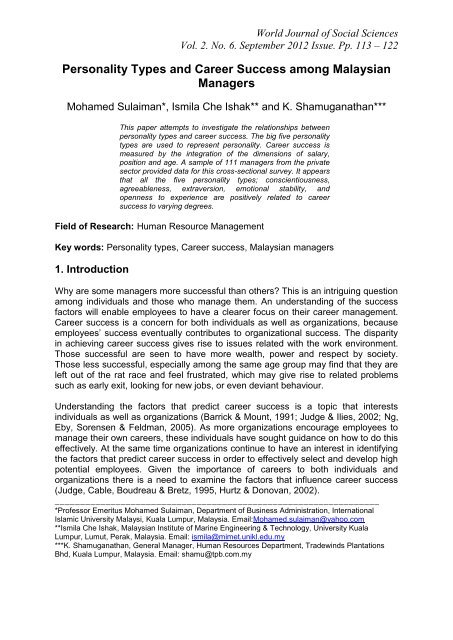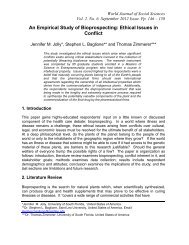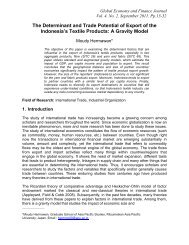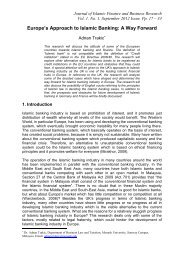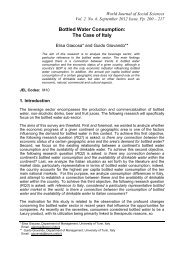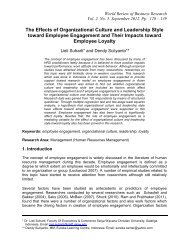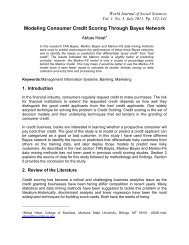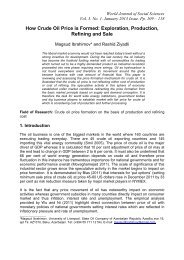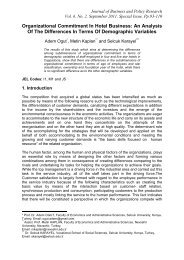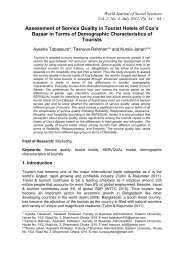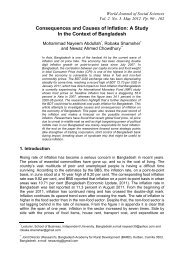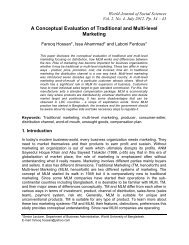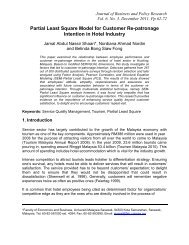Personality Types and Career Success among ... - Wbiaus.org
Personality Types and Career Success among ... - Wbiaus.org
Personality Types and Career Success among ... - Wbiaus.org
You also want an ePaper? Increase the reach of your titles
YUMPU automatically turns print PDFs into web optimized ePapers that Google loves.
World Journal of Social Sciences<br />
Vol. 2. No. 6. September 2012 Issue. Pp. 113 – 122<br />
<strong>Personality</strong> <strong>Types</strong> <strong>and</strong> <strong>Career</strong> <strong>Success</strong> <strong>among</strong> Malaysian<br />
Managers<br />
Mohamed Sulaiman*, Ismila Che Ishak** <strong>and</strong> K. Shamuganathan***<br />
This paper attempts to investigate the relationships between<br />
personality types <strong>and</strong> career success. The big five personality<br />
types are used to represent personality. <strong>Career</strong> success is<br />
measured by the integration of the dimensions of salary,<br />
position <strong>and</strong> age. A sample of 111 managers from the private<br />
sector provided data for this cross-sectional survey. It appears<br />
that all the five personality types; conscientiousness,<br />
agreeableness, extraversion, emotional stability, <strong>and</strong><br />
openness to experience are positively related to career<br />
success to varying degrees.<br />
Field of Research: Human Resource Management<br />
Key words: <strong>Personality</strong> types, <strong>Career</strong> success, Malaysian managers<br />
1. Introduction<br />
Why are some managers more successful than others? This is an intriguing question<br />
<strong>among</strong> individuals <strong>and</strong> those who manage them. An underst<strong>and</strong>ing of the success<br />
factors will enable employees to have a clearer focus on their career management.<br />
<strong>Career</strong> success is a concern for both individuals as well as <strong>org</strong>anizations, because<br />
employees’ success eventually contributes to <strong>org</strong>anizational success. The disparity<br />
in achieving career success gives rise to issues related with the work environment.<br />
Those successful are seen to have more wealth, power <strong>and</strong> respect by society.<br />
Those less successful, especially <strong>among</strong> the same age group may find that they are<br />
left out of the rat race <strong>and</strong> feel frustrated, which may give rise to related problems<br />
such as early exit, looking for new jobs, or even deviant behaviour.<br />
Underst<strong>and</strong>ing the factors that predict career success is a topic that interests<br />
individuals as well as <strong>org</strong>anizations (Barrick & Mount, 1991; Judge & Ilies, 2002; Ng,<br />
Eby, Sorensen & Feldman, 2005). As more <strong>org</strong>anizations encourage employees to<br />
manage their own careers, these individuals have sought guidance on how to do this<br />
effectively. At the same time <strong>org</strong>anizations continue to have an interest in identifying<br />
the factors that predict career success in order to effectively select <strong>and</strong> develop high<br />
potential employees. Given the importance of careers to both individuals <strong>and</strong><br />
<strong>org</strong>anizations there is a need to examine the factors that influence career success<br />
(Judge, Cable, Boudreau & Bretz, 1995, Hurtz & Donovan, 2002).<br />
________________________________________________________________<br />
*Professor Emeritus Mohamed Sulaiman, Department of Business Administration, International<br />
Islamic University Malaysi, Kuala Lumpur, Malaysia. Email:Mohamed.sulaiman@yahoo.com<br />
**Ismila Che Ishak, Malaysian Institute of Marine Engineering & Technology, University Kuala<br />
Lumpur, Lumut, Perak, Malaysia. Email: ismila@mimet.unikl.edu.my<br />
***K. Shamuganathan, General Manager, Human Resources Department, Tradewinds Plantations<br />
Bhd, Kuala Lumpur, Malaysia. Email: shamu@tpb.com.my
Sulaiman, Ishak & Shamuganathan<br />
An examination of the variables that influence career success shows that there a<br />
wide variety of factors that contribute to a person’s advancement in career. Ng, Eby,<br />
Sorenson & Feldman (2005) classified these factors into four categories, namely:<br />
human capital, <strong>org</strong>anization sponsorship, socio-demographic status, <strong>and</strong> stable<br />
individual differences (for example personality). This study focuses on only one<br />
variable, i.e the influence of individual differences toward career success.<br />
2. Literature Review<br />
2.1 <strong>Career</strong> <strong>Success</strong><br />
<strong>Career</strong> success is defined by Ng, Eby, Sorenson <strong>and</strong> Feldman (2005) as the<br />
accumulated positive work <strong>and</strong> psychological outcomes resulting from one’s work<br />
experiences. They operationalized career success in two ways. The first is the<br />
objective or extrinsic measure of career success, which includes salary attainment,<br />
the number of promotions <strong>and</strong> position level (Judge, et al, 1995). The second<br />
method of evaluating career success is through subjective or intrinsic measure, such<br />
as job <strong>and</strong> career satisfaction. These capture the individuals’ subjective judgement<br />
about their career achievements. Poon (2004) defined career success as the<br />
accumulation of achievements (real or perceived) arising from work experiences,<br />
which can be measured objectively or subjectively. Objective career success takes a<br />
third person perspective <strong>and</strong> subjective career success refers to a person’s own<br />
internal perspective of success. Recently Ballout (2009) studied the relationship<br />
between career success <strong>and</strong> career commitment, which was found to be positively<br />
related. This study uses an integrated objective measure, as career success index,<br />
which will be explained below.<br />
2.2 <strong>Personality</strong> Traits<br />
<strong>Personality</strong> traits have been shown to influence performance <strong>and</strong> career directions<br />
(Mount, Barrick & Strauss, 1994; Furnham, 2002; Schneider & Hough, 1995).<br />
McShane <strong>and</strong> Von Glinow (2008) define personality as ‘the relatively stable pattern<br />
of behaviours <strong>and</strong> consistent internal states that explain a person’s behavioural<br />
tendencies’. These behaviours of individuals in relation to their bosses, workmates<br />
<strong>and</strong> external parties such as customers, suppliers <strong>and</strong> other external parties would<br />
certainly influence outcomes of these behaviours including career success or failure.<br />
A number of studies indicated that personality traits influence or can be used to<br />
predict future career status or income, for example, Harrell (1972) (cited in Stagner<br />
(1976). It was found that income status of graduates was effectively predicted by<br />
personality traits. Mount et al (2005) posits that personality traits are one of the major<br />
non-cognitive domains in the field of psychology that influence numerous outcomes<br />
associated with work <strong>and</strong> life success. <strong>Personality</strong> effects behaviour through<br />
motivational processes <strong>and</strong> this would impact on the individual’s success in career<br />
<strong>and</strong> life. They influence the choices individuals make about which tasks <strong>and</strong> activities<br />
to engage in, how much effort to exert on those tasks, <strong>and</strong> how long to persist with<br />
those tasks.<br />
<strong>Personality</strong> types have categorized in a number of ways. The most prominent<br />
categorization of personality is perhaps the one proposed by McRea (1992 ) which is<br />
often referred to as the Big Five. Jalilv<strong>and</strong> (2000) found that personality types affect<br />
114
Sulaiman, Ishak & Shamuganathan<br />
a person’s goal-oriented behaviour <strong>and</strong> decision making. This study uses the Big<br />
Five personality types as predictors of career success.<br />
Digman (1990) suggested that personality is represented by five dimensions which<br />
are: conscientiousness, agreeableness, neuroticism, openness to experience, <strong>and</strong><br />
extraversion. Neuroticism is the opposite of emotional stability <strong>and</strong> for the purposes<br />
of this study neuroticism is replaced by emotional stability. Conscientiousness refers<br />
to people who are careful, dependable, responsible <strong>and</strong> have a will to succeed.<br />
Agreeableness refers to traits of courteousness, good-natured, empathy <strong>and</strong> caring.<br />
Emotional stability includes people who are poised, calm <strong>and</strong> secure. The dimension<br />
of openness to experience refers to the extent to which people are sensitive, flexible,<br />
creative, <strong>and</strong> curious. Extroversion characterizes people who are outgoing, talkative,<br />
sociable <strong>and</strong> assertive.<br />
These personality traits affect work related behaviour <strong>and</strong> job performance to varying<br />
degrees ((Judge & Ilies, 2002). People who are emotionally stable tend to work<br />
better than others in high stress situations. High agreeableness persons tend to<br />
h<strong>and</strong>le customer relations <strong>and</strong> conflict situations better. Conscientious employees<br />
tend to set higher goals <strong>and</strong> are more motivated (Mount & Barrick, 1995). By<br />
implication these conclusions seem to support the idea that personality traits or types<br />
are related to career success. This forms the main objective of this study.<br />
3. Research Framework<br />
Based on the literature above the following framework is built to guide the study. The general<br />
hypothesis is personality types significantly influence career success of managers.<br />
Figure 1: Research Framework<br />
<strong>Personality</strong> <strong>Types</strong><br />
Conscientiousness<br />
Agreeableness<br />
Emotional stability<br />
Openness to experience<br />
Extraversion<br />
<strong>Career</strong> <strong>Success</strong><br />
The sub-hypotheses are:<br />
H1.1: Conscientiousness personality type positively influences career success<br />
H1.2: Agreeableness personality type positively influences career success<br />
H1.3: Emotional stability personality type positively influences career success<br />
H1.4: Extraversion personality type positively influences career success<br />
H1.5: Openness to experience personality type positively influences career<br />
success.<br />
4. Methodology<br />
This study uses the survey method to collect data at one point in time. A<br />
questionnaire was prepared based on measurements used by previous researchers.<br />
The personality questionnaire (The Big Five Inventory of Goldberg) cited by<br />
Srivastava (2006) was adapted for the data collection on personality.<br />
115
Sulaiman, Ishak & Shamuganathan<br />
<strong>Career</strong> success in this study uses an index created from three variables, i.e age,<br />
salary level <strong>and</strong> job position. Ng et al. (2005) state that those who earn higher<br />
salaries <strong>and</strong> get promoted faster are regarded to be more successful. People have a<br />
tendency to compare themselves with others. Obtaining higher salaries <strong>and</strong> more<br />
promotions relative to others are likely to enhance one’s perception of success,<br />
because wealth <strong>and</strong> social st<strong>and</strong>ing are valued in society. Similarly those who attain<br />
higher salaries at a younger age would be regarded as more successful compared to<br />
those who get the same salary or position at a later age. Position or job title is<br />
another factor which can represent success. While these are extrinsic factors of<br />
success, they form tangible achievements which lead to career satisfaction.<br />
5. Findings<br />
5.1 <strong>Career</strong> <strong>Success</strong> Index<br />
For this study career success is measured as an index of three factors: age, salary,<br />
<strong>and</strong> position. The index is created as indicated in the tables 1, 2 <strong>and</strong> 3 below. Table<br />
1 shows that, if the respondent is 31 to 35, he or she would score 5 compared to a<br />
person who is 46 to 50 who would score only 2. Similarly, table 2 shows the index<br />
scores for position. An executive or section head would score 1, while a senior<br />
manager will score 4. Table 3 shows score for salary level. A person who draws a<br />
salary of between RM 2001 <strong>and</strong> 4000 will score 2, while a person who gets a salary<br />
of RM 8001 to 10,000 will get a score of 5.<br />
Table 1: Index for Age<br />
Age<br />
Index Score<br />
25 <strong>and</strong> below 7<br />
26 - 30 6<br />
31 - 35 5<br />
36 - 40 4<br />
41 - 45 3<br />
46 - 50 2<br />
51 <strong>and</strong> above 1<br />
Table 2: Index for Position<br />
Position<br />
Index score<br />
Executive/section head 1<br />
Assistant manager 2<br />
Manager 3<br />
Senior Manager 4<br />
Director 5<br />
General Manager/Managing Director 6<br />
President/CEO 7<br />
116
Sulaiman, Ishak & Shamuganathan<br />
Table 3: Index for Salary level<br />
Salary<br />
Index score<br />
RM 2000 <strong>and</strong> below 1<br />
RM 2001 - 4000 2<br />
RM 4001 - 6000 3<br />
RM 6001 - 8000 4<br />
RM 8001 – 10,000 5<br />
RM 10,001 – 12,000 6<br />
RM 12001 <strong>and</strong> above 7<br />
<strong>Career</strong> success index is calculated using the above index scores. <strong>Career</strong> success<br />
index =age score x position score x salary score. From this formulae the career<br />
success score will range from a minimum of 1 i.e. 1 x 1 x1 to a maximum of 343 i.e.<br />
7 x 7 x 7.<br />
The dependent variable is operationalized as an index because concrete data is<br />
preferred to enable to establish degrees of success; each respondent can be given a<br />
success index quite objectively. As an example, the calculation for the scores of<br />
success index will be as in table 4 below.<br />
Respon<br />
dent<br />
Table 4: Calculation of <strong>Career</strong> <strong>Success</strong> Scores<br />
Age Salary Position Age<br />
index<br />
Salary<br />
index<br />
Position<br />
index<br />
Calculation<br />
<strong>Career</strong><br />
<strong>Success</strong><br />
Score<br />
<strong>Career</strong><br />
<strong>Success</strong><br />
Score<br />
A 36 11,000 General 4 6 6 4x6x6 144<br />
Manager<br />
B 46 5500 Manager 2 3 3 2x3x3 18<br />
C 38 7000 Senior<br />
Manager<br />
4 4 4 4x4x4 64<br />
From table 4 it could be seen that Mr A is the most successful with a score of144,<br />
while Mr C is somewhat successful with a score of 64 <strong>and</strong> Mr B is lagging behind at<br />
a score of only 18.<br />
5.2 Questionnaire <strong>and</strong> Pilot Study<br />
The questionnaire on <strong>Personality</strong> was adapted from Srivastava (2006), plus the<br />
questionnaire on the individual <strong>and</strong> the <strong>org</strong>anization. It was pilot tested on 20<br />
respondents in an <strong>org</strong>anization where one the researchers was working. The<br />
feedback from the respondents seemed to indicate that they did not face difficulties<br />
in underst<strong>and</strong>ing, but commented that there were some repetitions. The<br />
questionnaire was amended accordingly.<br />
117
5.3 Population <strong>and</strong> Sample<br />
Sulaiman, Ishak & Shamuganathan<br />
The population of the study are managerial <strong>and</strong> executive level employees in the<br />
private sector of Malaysia as the unit of analysis is the individual manager. Sixty<br />
large companies in Kuala Lumpur, Penang, Ipoh <strong>and</strong> Seremban were contacted for<br />
agreement to participate in this study. Five sets of questionnaires were given to each<br />
company (through the Human Resource Manager) to be distributed to executives<br />
<strong>and</strong> managers of various age groups <strong>and</strong> levels. The distribution <strong>and</strong> collection of<br />
the questionnaire were done both by post <strong>and</strong> by h<strong>and</strong>. Out of 300 distributed to 60<br />
companies only 111 were returned, giving a response rate of 29%.<br />
Table 5: Profile of Respondents <strong>and</strong> Companies<br />
Age<br />
51 <strong>and</strong> above<br />
46 – 50<br />
41 – 45<br />
36 – 40<br />
30 – 35<br />
26 – 30<br />
25 <strong>and</strong> below<br />
Frequency %<br />
18<br />
24<br />
21<br />
12<br />
18<br />
15<br />
3<br />
16%<br />
22<br />
19<br />
11<br />
16<br />
13<br />
3<br />
Position<br />
Executive<br />
Asst. Manager<br />
Manager<br />
Senior Manager<br />
Director<br />
General Manager/MD<br />
President/CEO<br />
Salary level<br />
RM 2000 & below<br />
2001 – 4000<br />
4001 – 6000<br />
6001 – 8000<br />
8001 – 10,000<br />
10,001 – 12,000<br />
12,001 & above<br />
Related to owner Yes<br />
No<br />
Educational level SPM/MCE<br />
Diploma<br />
Bachelor’s Degree<br />
Master/Post grad<br />
Gender<br />
Male<br />
Female<br />
Years worked Less than 2<br />
2 – 5<br />
5 – 10<br />
Company Size<br />
(employees)<br />
Above 10 years<br />
11 – 100<br />
101 – 200<br />
201 – 500<br />
501 – 1000<br />
1001 - 3000<br />
27<br />
6<br />
21<br />
27<br />
12<br />
18<br />
0<br />
9<br />
27<br />
15<br />
24<br />
9<br />
0<br />
27<br />
0<br />
111<br />
9<br />
21<br />
51<br />
30<br />
81<br />
30<br />
3<br />
15<br />
18<br />
75<br />
3<br />
6<br />
54<br />
45<br />
3<br />
24<br />
5<br />
19<br />
24<br />
11<br />
16<br />
8<br />
24<br />
14<br />
22<br />
8<br />
0<br />
24<br />
0<br />
100<br />
8<br />
19<br />
46<br />
27<br />
73<br />
27<br />
3<br />
14<br />
16<br />
68<br />
3<br />
5<br />
49<br />
41<br />
3<br />
118
Sulaiman, Ishak & Shamuganathan<br />
Table 4 shows that data were obtained from 111 respondents representing medium<br />
to large companies. Most (90 %) of the sample were drawn from companies<br />
employing 200 to 1000 staff (medium to large). In terms of age, the sample seems to<br />
be evenly distributed, with 41% in the 41 to 50 age group. For position there no<br />
CEOs or presidents in the sample; 43% were in the positions of manager or senior<br />
manager. For salary level the range RM 10,000 to 12,000 were not represented, but<br />
the rest were there.<br />
The questionnaire also specifically asked whether the respondent was related to the<br />
owner, the result showed that no respondent was related to the owner. This was to<br />
ensure that favouritism due blood relationship was eliminated.<br />
Two other variables are also captured in this study <strong>and</strong> these are satisfaction level<br />
with current career achievement <strong>and</strong> comparing career achievement with others.<br />
These two variables are used to check for their correlations with the calculated<br />
career success index. The data on these variables are shown in table 6.<br />
Satisfaction with Current<br />
<strong>Career</strong> Achievement<br />
Table 6: Satisfaction with Current <strong>Career</strong> Achievement<br />
Variable Items Frequency %<br />
Totally not satisfied<br />
9<br />
8<br />
Not Satisfied<br />
33<br />
30<br />
Moderately satisfied<br />
42<br />
38<br />
Very satisfied<br />
27<br />
24<br />
Comparing <strong>Career</strong><br />
achievement with others<br />
Much worse than them<br />
Worse than them<br />
Same as them<br />
Better than them<br />
Much better than them<br />
Table 6 shows that the respondents represent wide spectrum of experiences from<br />
those who are dissatisfied with their career advancement (38%) <strong>and</strong> those who are<br />
satisfied or very satisfied (62%). Comparing their achievements with others, 46%<br />
viewed themselves as achieving below their cohorts, while 49% said they achieved<br />
better or much better.<br />
A Pearson correlation was conducted on the three main variables representing<br />
career success, i.e. <strong>Career</strong> <strong>Success</strong> index, satisfaction with current career<br />
achievement <strong>and</strong> comparing career achievement with others. The results are shown<br />
in table 7.<br />
12<br />
24<br />
21<br />
39<br />
15<br />
Table 7: Correlation with <strong>Career</strong> <strong>Success</strong> Index<br />
11<br />
35<br />
19<br />
35<br />
14<br />
Satisfaction with<br />
<strong>Career</strong><br />
Satisfaction with career 1<br />
achievement<br />
Comparing career .83<br />
achievement with others (.00)<br />
C.S. Index .62<br />
(.00)<br />
Comparing career<br />
with others<br />
1<br />
.64<br />
(.00)<br />
<strong>Career</strong> success<br />
index<br />
1<br />
119
Sulaiman, Ishak & Shamuganathan<br />
Table 7 shows that satisfaction with career achievement, comparing career<br />
achievement with others <strong>and</strong> <strong>Career</strong> <strong>Success</strong> index are highly <strong>and</strong> significantly<br />
correlated. This shows that career success index calculated is a good representation<br />
of career achievement <strong>and</strong> satisfaction.<br />
5.4 Correlation between personality traits <strong>and</strong> career success<br />
Table 8 shows the correlation between personality traits <strong>and</strong> career success. It<br />
shows that extroversion is significantly related to career success (r =.447, p = .01),<br />
conscientiousness is strongly related to career success (r = .624, p = .01) <strong>and</strong><br />
openness is weakly related to career success (r = .212, p. = 05). Agreeableness is<br />
not related to career success.<br />
Table 8: Correlation between personality traits <strong>and</strong> career success<br />
Variables Extroversion Agree Conscientiousness Emotion Openness<br />
Extroversion 1<br />
Agree -.488** 1<br />
Consc. .671** -.476** 1<br />
Emotion .102* -.387** -.027 1<br />
Openness -.279** .428** .106** -.536** 1<br />
<strong>Career</strong> .447** .023 .624** -.084 .212**<br />
success<br />
Mean 4.24 3.23 4.78 2.74 3.08<br />
** = < .01, * =< .05<br />
Regression results of personality types onto career success<br />
Table 9 shows the regression results of personality types on career success.<br />
Table 9: Regression results of personality types on career success.<br />
Variables Std beta T - value Sig.<br />
Extraversion<br />
Agreeableness<br />
Conscientiousness<br />
Emotional stability<br />
.208<br />
.459<br />
.718<br />
.135<br />
13.68<br />
36.11<br />
44.42<br />
11.19<br />
.00<br />
.00<br />
.00<br />
.00<br />
Openness to .055<br />
3.85<br />
.00<br />
experience<br />
R sq =.553<br />
Adj R sq = .553<br />
F-value = 1146.44<br />
Sig = .000<br />
It may be seen from table 9 that the model is significant <strong>and</strong> is able to explain 55% of<br />
the variances in career success. All the variables of personality traits are significant,<br />
in other words all the hypotheses are supported; but the most important ones are<br />
conscientiousness (r = .718, p =.00), agreeableness (r = .459, p =.00) <strong>and</strong><br />
extraversion (r = .208, p = .00). Emotional stability is also significant (r=.135, p=.00)<br />
but openness to experience is weakly significant (r=.055, p=.00).<br />
120
6. Summary <strong>and</strong> Conclusions<br />
Sulaiman, Ishak & Shamuganathan<br />
It is found that all the personality traits have positive correlations with career success<br />
but conscientiousness <strong>and</strong> agreeableness have the strongest correlations with<br />
career success. These are obviously essential characteristics for successful<br />
managers. However, we note that agreeableness on its own is not significantly<br />
related (r=.023) to career success, it seems to work only in conjunction with other<br />
variables. In other words, being a ‘yes man’ without substance does not always<br />
work. These results support the views <strong>and</strong> findings of Barrick & Mount (2005) <strong>and</strong> Ng<br />
et al (2005).<br />
The finding of this study highlights that it is useful for managers to underst<strong>and</strong> that in<br />
order to succeed in their careers they have to be first <strong>and</strong> foremost conscientious<br />
about their jobs <strong>and</strong> responsibilities. Second, they have to be an agreeable person<br />
especially in the Malaysian context, where a quarrelsome or argumentative<br />
personality is often frowned upon. A little bit of extraversion can help. Openness to<br />
new experience personality or a person who likes to experiment is very weakly<br />
related to success. Top managers in Malaysia can be rather conservative.<br />
Another contribution of this study is the use of career success index to represent<br />
career success. <strong>Career</strong> success index was created from three variables age, salary<br />
<strong>and</strong> position, which was found to be strongly correlated with career satisfaction <strong>and</strong><br />
career achievement. This index is an objective measure, which may be easily<br />
replicated for future studies.<br />
From the perspective <strong>org</strong>anizations, the findings may provide some guide for the<br />
selection of new employees <strong>and</strong> training of existing ones. In order to enhance career<br />
success the selection <strong>and</strong> training should emphasize the traits which are strongly<br />
related to career success.<br />
Overall the study indicates that personality plays a significant role in career success<br />
of managers. In order to succeed they have develop certain traits which are<br />
compatible with <strong>org</strong>anizational success.<br />
References<br />
Ballout IH 2009, ‘<strong>Career</strong> commitment <strong>and</strong> career success, moderating role of selfefficacy’,<br />
<strong>Career</strong> Development International, 14(7), pp.655-670.<br />
Barrick, MR <strong>and</strong> Mount, MK 1991, ‘The Big Five personality dimensions <strong>and</strong> job<br />
performance: A meta- analysis’, Personnel Psychology, Spring, pp1-26.<br />
Barrick, MR <strong>and</strong> Mount, MK 2005, ‘Yes, <strong>Personality</strong> Matters: Moving on to More<br />
important Matters’, Human Performance, 18(4), pp.359-372.<br />
Digman JM 1990, ‘<strong>Personality</strong> structure emergence of the Five Factor Model’,<br />
Annual Review of Psychology, 41, pp.417-440.<br />
Furnham A 2002, ‘Remember to manage upwards five traits are important when<br />
assessing the personality of the boss <strong>and</strong> maintaining a good working<br />
relationship’, Financial Times, May 14, pp.17.<br />
Hurtz, GM <strong>and</strong> Donovan, JJ 2000, <strong>Personality</strong> <strong>and</strong> Job performance: The Big Five<br />
Revisited, Journal of Applied Psychology, December, pp.869-879.<br />
Jalilv<strong>and</strong> M 2000, ‘Married women, work <strong>and</strong> values’, Monthly Labour Review,<br />
123(8), pp. 14-25.<br />
121
Sulaiman, Ishak & Shamuganathan<br />
Judge, TA, Cable, DM, Boudreau JW <strong>and</strong> Bretz RD 1995, ‘An Empirical investigation<br />
of the predictors of executive career success’, Personnel Psychology, 48,<br />
pp.485-519.<br />
Judge, TA <strong>and</strong> Ilies, R 2002, Relationship of personality to performance motivation,<br />
A meta-analytic review, Journal of Applied Psychology, 87(4), pp.797-807.<br />
McRea RR 1992, Special Issue: The Five Factor Model: Issues <strong>and</strong> Applications,<br />
Journal of <strong>Personality</strong>, June.<br />
McShane, SL <strong>and</strong> Von Glinow, MA 2008, Organizational Behaviour, McGraw-Hill<br />
Irwin, Boston.<br />
Mount, MK, Barrick, MR <strong>and</strong> Strauss 1994, Validity of observer ratings of the Big five<br />
personality factors, Journal of Applied Psychology, April, pp.272.<br />
Mount, MK <strong>and</strong> Barrick MR 1995, ‘The Big Five <strong>Personality</strong> dimensions: Implications<br />
for research <strong>and</strong> practice in Human Resource Management’, Research in<br />
Personnel <strong>and</strong> HRM, 13, pp.153-200.<br />
Mount, MK, Barrick MR, Scullen SM <strong>and</strong> Rounds J 2005, ‘Higher order of the big five<br />
personality traits <strong>and</strong> the big vocational interest types’, Personnel Psychology,<br />
58,(2), pp.447-479.<br />
Ng T, Eby LT, Sorensen KL <strong>and</strong> Feldman DC 2005, ‘Predictors of objective <strong>and</strong><br />
subjective career success: A meta-analysis’, Personnel Psychology, 58(2),<br />
pp.367-409.<br />
Poon, JML 2004, ‘<strong>Career</strong> commitment <strong>and</strong> career success: modelling role of emotion<br />
perception’, <strong>Career</strong> Development International, 9(4), pp.374-386.<br />
Schneider, RJ <strong>and</strong> Hough LM 1995, ‘<strong>Personality</strong> <strong>and</strong> Industrial/<strong>org</strong>anizational<br />
psychology’, International Review of Industrial <strong>and</strong> Organizational<br />
Psychology,10, pp.75-129.<br />
Srivastava, S 2006, ‘Measuring the Big Five <strong>Personality</strong> Dimensions’, retrieved on 17<br />
April 2006,<br />
Stagner R 1976, Traits are relevant: Theoretical analysis <strong>and</strong> empirical evidence,<br />
International Journal of Psychology <strong>and</strong> <strong>Personality</strong>, John Wiley & Sons, New<br />
York, pp.109-121.<br />
122


